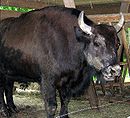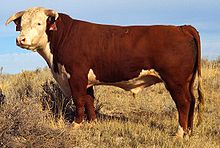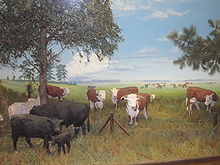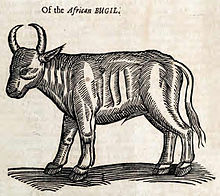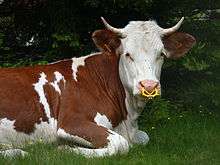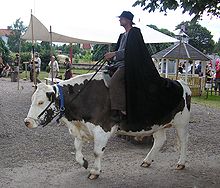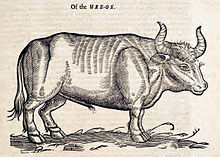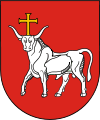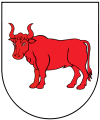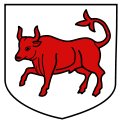- Cattle
-
"Cow" redirects here. For other uses, see Cow (disambiguation).For other uses, see Cattle (disambiguation).
Cattle 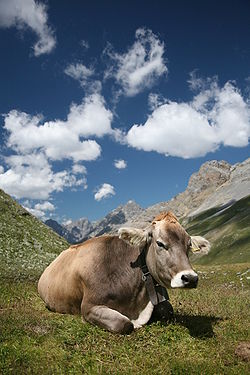
A Swiss Braunvieh cow wearing a cowbell Conservation status DomesticatedScientific classification Kingdom: Animalia Phylum: Chordata Class: Mammalia Subclass: Theria Infraclass: Eutheria Order: Artiodactyla Family: Bovidae Subfamily: Bovinae Genus: Bos Species: B. primigenius Subspecies: B. p. taurus,
B. p. indicusBinomial name Bos primigenius
Bojanus, 1827[1]Trinomial name Bos primigenius taurus,
Bos primigenius indicus
Bovine range Synonyms Bos taurus,
Bos indicusCattle (colloquially cows) are the most common type of large domesticated ungulates. They are a prominent modern member of the subfamily Bovinae, are the most widespread species of the genus Bos, and are most commonly classified collectively as Bos primigenius. Cattle are raised as livestock for meat (beef and veal), as dairy animals for milk and other dairy products, and as draft animals (oxen / bullocks) (pulling carts, plows and the like). Other products include leather and dung for manure or fuel. In some countries, such as India, cattle are sacred. It is estimated that there are 1.3 billion cattle in the world today.[2] In 2009, cattle became the first livestock animal to have its genome mapped.[3]
Contents
Species
Main article: BoviniCattle were originally identified as three separate species. These were Bos taurus, the European or "taurine" cattle (including similar types from Africa and Asia); Bos indicus, the zebu; and the extinct Bos primigenius, the aurochs. The aurochs is ancestral to both zebu and taurine cattle. Recently these three have increasingly been grouped as one species, with Bos primigenius taurus, Bos primigenius indicus and Bos primigenius primigenius as the subspecies.[4]
Complicating the matter is the ability of cattle to interbreed with other closely related species. Hybrid individuals and even breeds exist, not only between taurine cattle and zebu (including the sanga cattle breeds, Bos taurus africanus) but also between one or both of these and some other members of the genus Bos: yak (called a dzo or "yattle"[5]), banteng and gaur. Hybrids (such as the beefalo breed) can also occur between taurine cattle and either species of bison, which some authors consider to be in the genus Bos as well.[6] The hybrid origin of some types may not be obvious – for example, genetic testing of the Dwarf Lulu breed, the only taurine-type cattle in Nepal, found them to be a mix of taurine cattle, zebu and yak.[7] Cattle cannot successfully be hybridized with more distantly related bovines such as water buffalo or African buffalo.
The aurochs originally ranged throughout Europe, North Africa, and much of Asia. In historical times its range became restricted to Europe, and the last known individual died in Masovia, Poland, in about 1627.[8] Breeders have attempted to recreate cattle of similar appearance to aurochs by crossing traditional types of domesticated cattle, creating the Heck cattle breed.
Word origin
Cattle did not originate as the term for bovine animals. It was borrowed from Old French catel, itself from Latin caput, head, and originally meant movable personal property, especially livestock of any kind, as opposed to real property (the land, which also included wild or small free-roaming animals such as chickens — they were sold as part of the land).[9] The word is closely related to "chattel" (a unit of personal property) and "capital" in the economic sense.[10][11] The term replaced earlier Old English feoh "cattle, property" (cf. German: Vieh, Gothic: faihu).
The word cow came via Anglo-Saxon cū (plural cȳ), from Common Indo-European gʷōus (genitive gʷowes) = "a bovine animal", compare Persian Gâv, Sanskrit go, Welsh buwch.[citation needed] The genitive plural of "cū" is "cȳna", which gave the now archaic English plural, and Scots plural, of "kine".
In older English sources such as the King James Version of the Bible, "cattle" refers to livestock, as opposed to "deer" which refers to wildlife. "Wild cattle" may refer to feral cattle or to undomesticated species of the genus Bos. Today, when used without any other qualifier, the modern meaning of "cattle" is usually restricted to domesticated bovines.[citation needed]
Terminology
Cattle exhibit at Louisiana State Exhibit Museum in Shreveport
In general, the same words are used in different parts of the world but with minor differences in the definitions. The terminology described here contrasts the differences in definition between the United Kingdom and other British influenced parts of world such as Canada, Australia, New Zealand, Ireland, and the United States.[12]
- An intact (i.e., not castrated) adult male is called a bull. A wild, young, unmarked bull is known as a micky in Australia.[13] An unbranded bovine of either sex is called a maverick in the USA and Canada.
- An adult female that has had a calf (or two, depending on regional usage) is a cow.
- A young female before she has had a calf of her own[14] and is under three years of age is called a heifer (pronounced /ˈhɛfər/, "heffer").[15] A young female that has had only one calf is occasionally called a first-calf heifer.
- Young cattle of both sexes are called calves until they are weaned, then weaners until they are a year old in some areas; in other areas, particularly with male beef cattle, they may be known as feeder-calves or simply feeders. After that, they are referred to as yearlings or stirks[16] if between one and two years of age.[17]
- A castrated male is called a steer in the United States; older steers are often called bullocks in other parts of the world[18] but in North America this term refers to a young bull. Piker bullocks are micky bulls that were caught, castrated and then later lost.[13] In Australia, the term "Japanese ox" is used for grain fed steers in the weight range of 500 to 650 kg that are destined for the Japanese meat trade.[19] In North America, draft cattle under four years old are called working steers. Improper or late castration on a bull results in it becoming a coarse steer known as a stag in Australia, Canada and New Zealand.[20] In some countries an incompletely castrated male is known also as a rig.
- A castrated male (occasionally a female or in some areas a bull) kept for draft purposes is called an ox (plural oxen); "ox" may also be used to refer to some carcase products from any adult cattle, such as ox-hide, ox-blood or ox-liver.[15]
- A springer is a cow or heifer close to calving.[21]
- In all cattle species, a female that is the twin of a bull usually becomes an infertile partial intersex, and is a freemartin.
- Neat (horned oxen, from which neatsfoot oil is derived), beef (young ox) and beefing (young animal fit for slaughtering) are obsolete terms, although poll, pollard or polled cattle are still terms in use for naturally hornless animals, or in some areas also for those that have been disbudded.
- Cattle raised for human consumption are called beef cattle. Within the beef cattle industry in parts of the United States, the older term beef (plural beeves) is still used to refer to an animal of either gender. Some Australian, Canadian, New Zealand and British people use the term beast, especially for single animals when the gender is unknown.[22]
- Cattle of certain breeds bred specifically for milk production are called milking or dairy cattle.;[12] a cow kept to provide milk for one family may be called a house cow or milker.
- The adjective applying to cattle in general is usually bovine. The terms "bull", "cow" and "calf" are also used by extension to denote the gender or age of other large animals, including whales, hippopotamuses, camels, elk and elephants
See also: List of animal namesSingular terminology issue
Cattle can only be used in the plural and not in the singular: it is a plurale tantum.[23] Thus one may refer to "three cattle" or "some cattle", but not "one cattle". There is no universally used singular form in modern English of "cattle", other than the sex- and age-specific terms such as cow, bull, steer and heifer. Historically, "ox" was a non-gender-specific term for adult cattle, but generally this is now used only for draft cattle, especially adult castrated males. The term is also incorporated into the names of other species such as the musk ox and "grunting ox" (yak), and is used in some areas to describe certain cattle products such as ox-hide and ox-tail.[24]
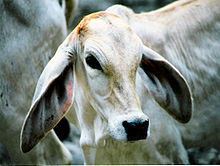 A Brahman calf
A Brahman calf
"Cow" is in general use as a singular for the collective "cattle", despite the objections by those who insist it to be a female-specific term. Although the phrase "that cow is a bull" is absurd from a lexicographic standpoint, the word "cow" is easy to use when a singular is needed and the sex is unknown or irrelevant - when "there is a cow in the road", for example. Further, any herd of fully mature cattle in or near a pasture is statistically likely to consist mostly of cows, so the term is probably accurate even in the restrictive sense. Other than the few bulls needed for breeding, the vast majority of male cattle are castrated as calves and slaughtered for meat before the age of three years. Thus, in a pastured herd, any calves or herd bulls usually are clearly distinguishable from the cows due to distinctively different sizes and clear anatomical differences. Merriam-Webster, a U.S. dictionary, recognizes the non-sex-specific use of "cow" as an alternate definition,[25] whereas Collins, a UK dictionary, does not.[26]
Colloquially, more general non-specific terms may denote cattle when a singular form is needed. Australian, New Zealand and British farmers use the term "beast" or "cattle beast". "Bovine" is also used in Britain. The term "critter" is common in the western United States and Canada, particularly when referring to young cattle.[27] In some areas of the American South (particularly the Appalachian region), where both dairy and beef cattle are present, an individual animal was once called a "beef critter", though that term is becoming archaic.
Other terminology
Cattle raised for human consumption are called "beef cattle". Within the beef cattle industry in parts of the United States, the term "beef" (plural "beeves") is still used in its archaic sense to refer to an animal of either gender. Cows of certain breeds that are kept for the milk they give are called "dairy cows" or "milking cows" (formerly "milch cows"). Most young male offspring of dairy cows are sold for veal, and may be referred to as veal calves.
The term "dogies" is used to describe orphaned calves in the context of ranch work in the American west, as in "Keep them dogies moving".[28] In some places, a cow kept to provide milk for one family is called a "house cow". Other obsolete terms for cattle include "neat" (this use survives in "neatsfoot oil", extracted from the feet and legs of cattle), and "beefing" (young animal fit for slaughter).
An onomatopoeic term for one of the commonest sounds made by cattle is "moo", and this sound is also called lowing. There are a number of other sounds made by cattle, including calves bawling, and bulls bellowing. The bullroarer makes a sound similar to a territorial call made by bulls.[citation needed]
Anatomy
Cattle have one stomach with four compartments. They are the rumen, reticulum, omasum, and abomasum, with the rumen being the largest compartment. The reticulum, the smallest compartment, is known as the "honeycomb". Cattle sometimes consume metal objects which are deposited in the reticulum and irritation from the metal objects causes hardware disease. The omasum's main function is to absorb water and nutrients from the digestible feed. The omasum is known as the "many plies". The abomasum is like the human stomach; this is why it is known as the "true stomach".
 Dairy farming and the milking of cattle - once performed largely by hand, but now usually replaced by machine – exploits the cow's ruminant biology.
Dairy farming and the milking of cattle - once performed largely by hand, but now usually replaced by machine – exploits the cow's ruminant biology.
Cattle are ruminants, meaning that they have a digestive system that allows use of otherwise indigestible foods by regurgitating and rechewing them as "cud". The cud is then reswallowed and further digested by specialised microorganisms in the rumen. These microbes are primarily responsible for decomposing cellulose and other carbohydrates into volatile fatty acids that cattle use as their primary metabolic fuel. The microbes inside the rumen are also able to synthesize amino acids from non-protein nitrogenous sources, such as urea and ammonia. As these microbes reproduce in the rumen, older generations die and their carcasses continue on through the digestive tract. These carcasses are then partially digested by the cattle, allowing them to gain a high quality protein source. These features allow cattle to thrive on grasses and other vegetation.
The gestation period for a cow is nine months. A newborn calf weighs 25 to 45 kilograms (55 to 99 lb). The world record for the heaviest bull was 1,740 kilograms (3,840 lb), a Chianina named Donetto, when he was exhibited at the Arezzo show in 1955.[29] The heaviest steer was eight year old ‘Old Ben’, a Shorthorn/Hereford cross weighing in at 2,140 kilograms (4,720 lb) in 1910.[30] Steers are generally killed before reaching 750 kilograms (1,650 lb). Breeding stock usually live to about 15 years (occasionally as much as 25 years). The oldest recorded cow, Big Bertha, died at the age of 48 in 1993.
A common misconception about cattle (particularly bulls) is that they are enraged by the color red (something provocative is often said to be "like a red flag to a bull"). This is incorrect, as cattle are red-green color-blind.[31][32] The myth arose from the use of red capes in the sport of bullfighting; in fact, two different capes are used. The capote is a large, flowing cape that is magenta and yellow. The more famous muleta is the smaller, red cape, used exclusively for the final, fatal segment of the fight. It is not the color of the cape that angers the bull, but rather the movement of the fabric that irritates the bull and incites it to charge.
Having two kinds of color receptors in the cone cells in their retinas, cattle are dichromatic, as are most other non-primate land mammals.[33][34]
A cow's udder contains 2 pairs of mammary glands.
Cattle genome
Further information: Bovine genomeIn the April 24, 2009 edition of the journal Science, it was reported that a team of researchers led by the National Institutes of Health and the U.S. Department of Agriculture has mapped the bovine genome.[35] The scientists found that cattle have approximately 22,000 genes, and 80 percent of their genes are shared with humans, and they have approximately 1,000 genes they share with dogs and rodents, but are not found in humans. Using this bovine "HapMap", researchers can track the differences between the breeds that affect the quality of meat and milk yields.[36]
Domestication and husbandry
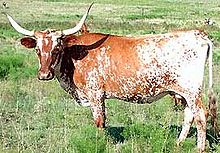 Texas Longhorns are a U.S. breed
Texas Longhorns are a U.S. breed
Cattle occupy a unique role in human history, domesticated since at least the early Neolithic. They are raised for meat (beef cattle), dairy products and hides. They are also used as draft animals and in certain sports. Some consider cattle the oldest form of wealth, and cattle raiding consequently one of the earliest forms of theft.
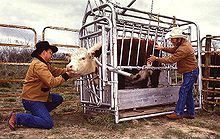 A Hereford being inspected for ticks; cattle are often restrained or confined in Cattle crushes when given medical attention.
A Hereford being inspected for ticks; cattle are often restrained or confined in Cattle crushes when given medical attention.
Cattle are often raised by allowing herds to graze on the grasses of large tracts of rangeland. Raising cattle in this manner allows the use of land that might be unsuitable for growing crops. The most common interactions with cattle involve daily feeding, cleaning and milking. Many routine husbandry practices involve ear tagging, dehorning, loading, medical operations, vaccinations and hoof care, as well as training for agricultural shows and preparations. There are also some cultural differences in working with cattle- the cattle husbandry of Fulani men rests on behavioural techniques, whereas in Europe cattle are controlled primarily by physical means like fences.[37] Breeders use cattle husbandry to reduce M. bovis infection susceptibility by selective breeding and maintaining herd health to avoid concurrent disease.[38]
Cattle are farmed for beef, veal, dairy, leather and they are less commonly used for conservation grazing, simply to maintain grassland for wildlife – for example, in Epping Forest, England. They are often used in some of the most wild places for livestock. Depending on the breed, cattle can survive on hill grazing, heaths, marshes, moors and semi desert. Modern cows are more commercial than older breeds and, having become more specialized, are less versatile. For this reason many smaller farmers still favor old breeds, like the dairy breed of cattle Jersey.
In Portugal, Spain, Southern France and some Latin American countries, bulls are used in the activity of bullfighting; a similar activity, Jallikattu, is seen in South India; in many other countries this is illegal. Other activities such as bull riding are seen as part of a rodeo, especially in North America. Bull-leaping, a central ritual in Bronze Age Minoan culture (see Bull (mythology)), still exists in southwestern France. In modern times, cattle are also entered into agricultural competitions. These competitions can involve live cattle or cattle carcases in hoof and hook events.
In terms of food intake by humans, consumption of cattle is less efficient than of grain or vegetables with regard to land use, and hence cattle grazing consumes more area than such other agricultural production when raised on grains.[39] Nonetheless, cattle and other forms of domesticated animals can sometimes help to use plant resources in areas not easily amenable to other forms of agriculture.
Sleep
Further information: Sleep (non-human)The average sleep time of a domestic cow is said to be only 4 hours a day.[40]
Use as food
Main article: BeefThe meat of adult cattle is known as beef, and that of calves is veal. Other parts of cattle are also used as food products, including blood, liver, kidney, heart and oxtail.
Economy
Cattle today are the basis of a multi-billion dollar industry worldwide. The international trade in beef for 2000 was over $30 billion and represented only 23 percent of world beef production. (Clay 2004). The production of milk, which is also made into cheese, butter, yogurt, and other dairy products, is comparable in economic size to beef production and provides an important part of the food supply for many of the world's people. Cattle hides, used for leather to make shoes, couches and clothing, are another widespread product. Cattle remain broadly used as draft animals in many developing countries, such as India.
Environmental impact
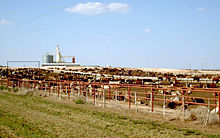 Cattle — especially when kept on enormous feedlots such as this one — have been named as a contributing factor in the rise in greenhouse gas emissions.
Cattle — especially when kept on enormous feedlots such as this one — have been named as a contributing factor in the rise in greenhouse gas emissions.
A 400-page United Nations report from the Food and Agriculture Organization (FAO) states that the livestock sector is "responsible for 18% of greenhouse gas emissions".[41] [42] The production of cattle to feed and clothe humans stresses ecosystems around the world,[39] and is assessed to be one of the top three environmental problems in the world on a local to global scale.[42]
The report, entitled Livestock's Long Shadow, also surveys the environmental damage from sheep, chickens, pigs and goats. But in almost every case, the world's 1.5 billion cattle are cited as the greatest adverse impact with respect to climate change as well as species extinction. The report concludes that, unless changes are made, the massive damage reckoned to be due to livestock may more than double by 2050, as demand for meat increases. One of the cited changes suggests that intensification of the livestock industry may be suggested, since intensification leads to less land for a given level of production.[42]
Some microbes respire in the cattle gut by an anaerobic process known as methanogenesis (producing the gas methane). Cattle emit a large volume of methane, 95% of it through burping (eructation), not flatulence.[43] As the carbon in the methane comes from the digestion of vegetation produced by photosynthesis, its release into the air by this process would normally be considered harmless, because there is no net increase in carbon in the atmosphere — it is removed as carbon dioxide from the air by photosynthesis and returned to it as methane.[citation needed] Methane is a more potent greenhouse gas than carbon dioxide, having a warming effect 23 to 50 times greater,[44][45] and according to Takahashi and Young "even a small increase in methane concentration in the atmosphere exerts a potentially significant contribution to global warming".[45] Further analysis of the methane gas produced by livestock as a contributor to the increase in greenhouse gases is provided by Weart.[46] Research is underway on methods of reducing this source of methane, by the use of dietary supplements, or treatments to reduce the proportion of methanogenetic microbes, perhaps by vaccination.[47][48] In 2010, a diet was proposed to reduce the emissions of greenhouse gases by cattle. The diet was conceived by Alexander Hristov of the Pennstate University.[49]
Cattle are fed a concentrated high-corn diet which produces rapid weight gain, but this has side effects which include increased acidity in the digestive system. When improperly handled, manure and other byproducts of concentrated agriculture also have environmental consequences.[50]
Grazing by cattle at low intensities can create a favourable environment for native herbs and forbs; however, in most world regions cattle are reducing biodiversity due to overgrazing driven by food demands by an expanding human population.[51]
Health
Cow urine is commonly used in India for medical purposes. It is distilled and then consumed by patients seeking treatment for a wide variety of illnesses. At present, there is no conclusive medical evidence that this has any effect.[52]
Oxen
Main article: OxOxen (singular ox) are cattle trained as draft animals. Often they are adult, castrated males of larger breeds, although females and entire bulls are also used in some areas. Usually an ox is over four years old due to the need for training and to allow it to grow to full size. Oxen are used for plowing, transport, hauling cargo, grain-grinding by trampling or by powering machines, irrigation by powering pumps, and wagon drawing. Oxen were commonly used to skid logs in forests, and sometimes still are, in low-impact select-cut logging. Oxen are most often used in teams of two, paired, for light work such as carting, with additional pairs added when more power is required, sometimes up to a total of twenty or more.
An ox is a mature bovine who has learned to respond appropriately to a teamster's signals. These signals are given by verbal commands or by noise (whip cracks). Verbal commmands vary according to dialect and local tradition. In one tradition in North America, the commands are:[citation needed]
- Get up: walk forward
- Whoa: stop
- Back up: go backwards
- Gee: turn right
- Haw: turn left
Oxen can pull harder and longer than horses. Though not as fast as horses, they are less prone to injury because they are more sure-footed.
Many oxen are used worldwide, especially in developing countries.
Religion, traditions and folklore
Main article: Cattle in religionHindu tradition
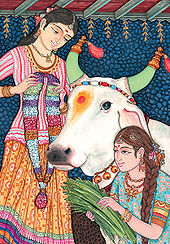 In Hinduism, the cow is a symbol of wealth, strength, abundance, selfless giving and a full Earthly life.
In Hinduism, the cow is a symbol of wealth, strength, abundance, selfless giving and a full Earthly life.
Cattle are venerated within the Hindu religion of India.[clarification needed] According to Vedic scriptures they are to be treated with the same respect 'as one's mother' because of the milk they provide; "The cow is my mother" (Mahabharata)[53] They appear in numerous stories from the Puranas and Vedas. The deity Krishna was brought up in a family of cowherders, and given the name Govinda (protector of the cows). Also Shiva is traditionally said to ride on the back of a bull named Nandi. In ancient rural India every household had a few cows which provided a constant supply of milk and a few bulls that helped as draft animals.[citation needed]
Observant Hindus, even though they might eat meat of other animals, almost always abstain from beef, and the slaughter of cows is considered a heinous sin in mainstream Orthodox Hinduism. Slaughter of cows (including oxen, bulls and calves) is forbidden by law in several states of the Indian Union. McDonalds outlets in India do not serve any beef burgers. At one time the death sentence was imposed for killing a cow in India,[54] and as late as 1960, an individual could serve three months in jail for killing a pedestrian, but one year for injuring a cow, and life imprisonment for killing a cow.[55]
Other traditions
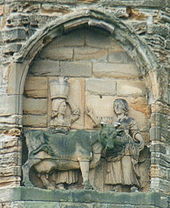 Legend of the founding of Durham Cathedral is that monks carrying the body of Saint Cuthbert were led to the location by a milk maid who had lost her dun cow, which was found resting on the spot.
Legend of the founding of Durham Cathedral is that monks carrying the body of Saint Cuthbert were led to the location by a milk maid who had lost her dun cow, which was found resting on the spot.
- The Evangelist St. Luke is depicted as an ox in Christian art.
- In Judaism, as described in Numbers 19:2, the ashes of a sacrificed unblemished red heifer that has never been yoked can be used for ritual purification of people who came into contact with a corpse.
- The ox is one of the 12-year cycle of animals which appear in the Chinese zodiac related to the Chinese calendar. See: Ox (Zodiac).
- The constellation Taurus represents a bull.
- An apocryphal story has it that a cow started the Great Chicago Fire by kicking over a kerosene lamp. Michael Ahern, the reporter who created the cow story, admitted in 1893 that he had fabricated it for more colorful copy.
- On February 18, 1930, Elm Farm Ollie became the first cow to fly in an airplane and also the first cow to be milked in an airplane.
- The first known law requiring branding in North America was enacted on February 5, 1644, by Connecticut. It said that all cattle and pigs had to have a registered brand or earmark by May 1, 1644.[56]
- The akabeko (赤べこ, red cow) is a traditional toy from the Aizu region of Japan that is thought to ward off illness.[57]
- The case of Sherwood v. Walker -- involving a supposedly barren heifer that was actually pregnant—-first enunciated the concept of mutual mistake as a means of destroying the meeting of the minds in contract law.[citation needed]
- The Maasai tribe of East Africa traditionally believe that all cows on earth are the God-given property of the Maasai
In heraldry
Cattle are typically represented in heraldry by the bull.
-
Arms of Bielsk Podlaski, Poland -
Arms of Turek, Poland
See also: Ciołek coat of armsPopulation
The world cattle population is estimated to be about 1.3 billion[2]. The following table shows the cattle population in 2009[58]
Africa has about 20,000,000 head of cattle, many of which are raised in traditional ways and serve partly as tokens of their owner's wealth.[citation needed]
Cattle population (View diagram) Region Cattle population India 281,700,000 Brazil 187,087,000 China 139,721,000 US 96,669,000 EU-27 87,650,000 Argentina 51,062,000 Australia 29,202,000 Mexico 26,489,000 Russian Federation 18,370,000 South Africa 14,187,000 Canada 13,945,000 Other 49,756,000 See also
- 1966 anti-cow slaughter agitation
- Aurochs (extinct)
- Bovine genome
- British Cattle Health Initiative
- Bull-baiting
- Bullocky
- Bulls and Cows (game)
- Cattle age determination
- Cattle judging
- Cattle raiding
- Cow tipping
- Cowboy
- Dairy farming
- Dzo
- Factory farming
- Category:Individual cattle
- List of breeds of cattle
- List of domesticated animals
Notes
- ^ Grubb, Peter (16 November 2005). "Bos taurus primigenius". In Wilson, Don E., and Reeder, DeeAnn M., eds. Mammal Species of the World: A Taxonomic and Geographic Reference (3rd ed.). Baltimore: Johns Hopkins University Press, 2 vols. (2142 pp.). ISBN 978-0-8018-8221-0. OCLC 62265494. http://www.bucknell.edu/msw3/browse.asp?id=14200690.
- ^ a b Breeds of Cattle at CATTLE TODAY
- ^ Brown, David (2009-04-23). "Scientists Unravel Genome of the Cow". The Washington Post. http://www.washingtonpost.com/wp-dyn/content/article/2009/04/23/AR2009042303453.html. Retrieved 2009-04-23.
- ^ Opinions, Bulletin of Zoological Nomenclature 60 (1), 2003
- ^ "Yattle What?", Washington Post, August 11, 2007
- ^ Groves, C. P., 1981. Systematic relationships in the Bovini (Artiodactyla, Bovidae). Zeitschrift für Zoologische Systematik und Evolutionsforschung, 4:264-278., quoted in Grubb, Peter (16 November 2005). "Genus Bison". In Wilson, Don E., and Reeder, DeeAnn M., eds. Mammal Species of the World: A Taxonomic and Geographic Reference (3rd ed.). Baltimore: Johns Hopkins University Press, 2 vols. (2142 pp.). ISBN 978-0-8018-8221-0. OCLC 62265494. http://www.bucknell.edu/msw3/browse.asp?id=14200668.
- ^ Takeda, Kumiko; et al. (April 2004). "Mitochondrial DNA analysis of Nepalese domestic dwarf cattle Lulu". Animal Science Journal (Blackwell Publishing) 75 (2): 103–110. doi:10.1111/j.1740-0929.2004.00163.x. http://www.blackwell-synergy.com/links/doi/10.1111%2Fj.1740-0929.2004.00163.x. Retrieved 2006-11-07.
- ^ Van Vuure, C.T. 2003. De Oeros – Het spoor terug (in Dutch), Cis van Vuure, Wageningen University and Research Centrum: quoted by The Extinction Website: Bos primigenius primigenius.
- ^ Harper, Douglas (2001). "Cattle". Online Etymological Dictionary. http://www.etymonline.com/index.php?term=cattle. Retrieved 2007-06-13.
- ^ Harper, Douglas (2001). "Chattel". Online Etymological Dictionary. http://www.etymonline.com/index.php?term=chattel. Retrieved 2007-06-13.
- ^ Harper, Douglas (2001). "Capital". Online Etymological Dictionary. http://www.etymonline.com/index.php?term=capital. Retrieved 2007-06-13.
- ^ a b "Cattle Terminology". experiencefestival.com. http://www.experiencefestival.com/a/Cattle_-_Terminology/id/1287270.
- ^ a b Coupe, Sheena (ed.), Frontier Country, Vol. 1, Weldon Russell Publishing, Willoughby, 1989, ISBN 1-875202-01-3
- ^ "Definition of heifer". Merriam-Webster. http://webster.com/dictionary/heifer. Retrieved 2006-11-29.
- ^ a b Delbridge, Arthur, The Macquarie Dictionary, 2nd ed., Macquarie Library, North Ryde, 1991
- ^ McIntosh, E., The Concise Oxford Dictionary of Current English, Clarendon Press, 1967
- ^ Warren, Andrea. "Pioneer Girl: Growing Up on the Prairie" (PDF). Lexile. Archived from the original on 2006-11-01. http://web.archive.org/web/20061101003533/http://www.lexile.com/PowerV/Pioneer+Girl+Growng+Up+on+the+Prairie.pdf. Retrieved 2006-11-29.
- ^ Delbridge, A, et al., Macquarie Dictionary, The Book Printer, Australia, 1991
- ^ Meat & Livestock Australia, Feedback, June/July 2008
- ^ Sure Ways to Lose Money on Your Cattle
- ^ FAQs: What is meant by springer cows and heifers?, Dr. Rick Rasby, Professor of Animal Science, University of Nebraska - Lincoln, September 6th, 2005. Retrieved: 2010-08-12.
- ^ Australians Camdraft Assoc. Retrieved on 2009-7-31
- ^ "Cattle (5, 6)". Oxford English Dictionary. Oxford University Press. 2nd ed. 1989.
- ^ "Ox (1, 2)". Oxford English Dictionary. Oxford University Press. 2nd ed. 1989.
- ^ Merriam Webster Online
- ^ Collins Language.com
- ^ "Critter," definition 2.
- ^ Beales, Terry (1999). "Keep Those Dogies Movin!" (PDF). Texas Animal Health Commission News Release. Archived from the original on 2008-06-02. http://web.archive.org/web/20080602151855/http://www.tahc.state.tx.us/news/pr/1999/1999.08_CattleMove.pdf. Retrieved 2008-06-28.
- ^ Friend, John B., Cattle of the World, Blandford Press, Dorset, 1978
- ^ McWhirter, Norris & Ross, Guiness Book of Records, Redwood Press, Trowbridge, 1968
- ^ Itla.net, Longhorn information - handling.
- ^ "?". iacuc.tennessee.edu. http://iacuc.tennessee.edu/pdf/Policies-AnimalCare/Cattle-BasicCare.pdf.[dead link]
- ^ Jacobs, G. H., J. F.Deegan, and J. Neitz. 1998. Photopigment basis for dichromatic color vision in cows, goats and sheep. Vis. Neurosci. 15:581–584
- ^ Perception of Color by Cattle and its Influence on Behavior C.J.C. Phillips* and C. A. Lomas†2 J. Dairy Sci. 84:807–813
- ^ "Cow genome unraveled in bid to improve meat, milk". AP. 2009-04-23. http://news.yahoo.com/s/ap/20090423/ap_on_sc/us_sci_bovine_basics. Retrieved 2009-04-23.[dead link]
- ^ BBC: Cow genome 'to transform farming'
- ^ Lott, Dale F.; Hart, Benjamin L. (October 1979). "Applied ethology in a nomadic cattle culture". Applied Animal Ethology (Elsevier B.V.) 5 (4): 309–319. doi:10.1016/0304-3762(79)90102-0.
- ^ Krebs JR, Anderson T, Clutton-Brock WT, et al. (1997) (PDF). Bovine tuberculosis in cattle and badgers: an independent scientific review. Ministry of Agriculture, Fisheries and Food. http://www.defra.gov.uk/animalh/tb/publications/hpanel.pdf. Retrieved 2006-09-04.
- ^ a b Edward O. Wilson, The Future of Life, 2003, Vintage Books, 256 pages ISBN 0-679-76811-4
- ^ "40 Winks?" Jennifer S. Holland, National Geographic Vol. 220, No. 1. July 2011.
- ^ "Livestock a major threat to environment". FAO Newsroom. http://www.fao.org/newsroom/en/news/2006/1000448/index.html.
- ^ a b c FAO LEAD Resources: Livestock’s long shadow — Environmental issues and options
- ^ "Bovine belching called udderly serious gas problem". Los Angeles Times, Sunday, July 13, 2003.
- ^ (pie charts)
- ^ a b Junichi Takahashi and Bruce A. Young, Greenhouse Gases and Animal Agriculture: Proceedings (2002) Elsevier Health Sciences, 372 pages ISBN 0-444-51012-5
- ^ Spencer Weart: The Discovery of Global Warming: "Other Greenhouse Gases". June 2007.
- ^ "Triad bid to stop belching". BBC News. 2006-01-04. http://news.bbc.co.uk/1/hi/scotland/4582174.stm. Retrieved 2006-01-04.
- ^ Research on use of bacteria from the stomach lining of kangaroos (who don't emit methane) to reduce methane in cattle
- ^ Unusual feed supplement could ease greenhouse gassy cows
- ^ Manure Management
- ^ E.O. Wilson, The Future of Life, 2003, Vintage Books, 256 pages ISBN 067976811
- ^ "(video) Indian Doctors Use Cow Urine As Medicine". http://online.wsj.com/video/indian-doctors-use-cow-urine-as-medicine/6E5E9BB4-B07A-418B-AAD3-C2121AEE0928.html?mod=WSJ_Article_Videocarousel_1. Retrieved 27 November 2010.
- ^ Mahabharata, Book 13-Anusasana Parva, Section LXXVI
- ^ Subramanian Swamy (21 November 2001). "Save the cow, save earth". Express Buzz. http://expressbuzz.com/Opinion/Op-Ed/save-the-cow-save-earth/123392.html. Retrieved 27 November 2010.
- ^ "Injured cow in Nepal is serious matter". Yahoo! News. http://news.google.com/newspapers?id=oegzAAAAIBAJ&sjid=5O4HAAAAIBAJ&dq=india%20cow%20killing%20life-imprisonment&pg=6924%2C2401380. Retrieved 27 November 2010.
- ^ Kane, J.; Anzovin, S., & Podell, J. (1997). Famous First Facts. New York, NY: H. W. Wilson Company. pp. 5. ISBN 0-8242-0930-3.
- ^ Madden, Thomas (May 1992). "Akabeko". OUTLOOK. Online copy accessed 18 January 2007.
- ^ [1]
References
- Bhattacharya, S. 2003. Cattle ownership makes it a man's world. Newscientist.com. Retrieved December 26, 2006.
- Cattle Today (CT). 2006. Website. Breeds of cattle. Cattle Today. Retrieved December 26, 2006
- Clay, J. 2004. World Agriculture and the Environment: A Commodity-by-Commodity Guide to Impacts and Practices. Washington, D.C., USA: Island Press. ISBN 1-55963-370-0.
- Clutton-Brock, J. 1999. A Natural History of Domesticated Mammals. Cambridge UK : Cambridge University Press. ISBN 0-521-63495-4.
- Purdy, Herman R.; R. John Dawes; Dr. Robert Hough (2008). Breeds Of Cattle (2nd ed.). http://www.breedsofcattle.net/. - A visual textbook containing History/Origin, Phenotype & Statistics of 45 breeds.
- Huffman, B. 2006. The ultimate ungulate page. UltimateUngulate.com. Retrieved December 26, 2006.
- Invasive Species Specialist Group (ISSG). 2005. Bos taurus. Global Invasive Species Database.
- Nowak, R.M. and Paradiso, J.L. 1983. Walker's Mammals of the World. Baltimore, Maryland, USA: The Johns Hopkins University Press. ISBN 0-8018-2525-3
- Oklahoma State University (OSU). 2006. Breeds of Cattle. Retrieved January 5, 2007.
- Public Broadcasting Service (PBS). 2004. Holy cow. PBS Nature. Retrieved January 5, 2007.
- Rath, S. 1998. The Complete Cow. Stillwater, Minnesota, USA: Voyageur Press. ISBN 0-89658-375-9.
- Raudiansky, S. 1992. The Covenant of the Wild. New York: William Morrow and Company, Inc. ISBN 0-688-09610-7.
- Spectrum Commodities (SC). 2006. Live cattle. Spectrumcommodities.com. Retrieved January 5, 2007.
- Voelker, W. 1986. The Natural History of Living Mammals. Medford, New Jersey, USA: Plexus Publishing, Inc. ISBN 0-937548-08-1.
- Yogananda, P. 1946. The Autobiography of a Yogi. Los Angeles, California, USA: Self Realization Fellowship. ISBN 0-87612-083-4.
Heraldic creatures Beasts 
Birds Legendary
creaturesBasilisk · Biscione · Chollima · Cockatrice · Dragon · Enfield · Garuda · Griffin/Keythong · Harpy · Lindworm · Manticore · Phoenix · Salamander · Turul · Unicorn · WyvernFish Others Categories:- Domesticated animals
- Cattle
- Herbivorous animals
- Sequenced genomes
- Animals described in 1827
Wikimedia Foundation. 2010.

